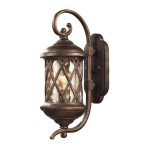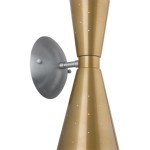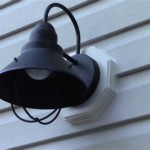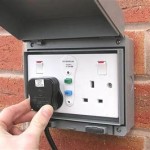Understanding Outdoor PIR Lights: Enhancing Security and Convenience
Outdoor PIR lights, short for Passive Infrared lights, are a widely used security and convenience feature for residential and commercial properties. These lights are designed to automatically illuminate an area when motion is detected within their range. This functionality is achieved through the integration of a Passive Infrared sensor, which detects changes in infrared radiation emitted by objects, such as humans or animals, moving within its field of view. This article will delve into the technology behind outdoor PIR lights, their various applications, factors to consider when choosing a PIR light, and proper installation and maintenance practices.
The primary function of an outdoor PIR light is to provide illumination when motion is detected, serving as a deterrent to potential intruders and enhancing safety by illuminating pathways and entry points. The sudden burst of light can startle intruders, making them reconsider their actions. Furthermore, PIR lights can improve visibility for residents and visitors, reducing the risk of accidents on dark walkways or steps. Beyond security applications, PIR lights also offer convenience by automatically lighting up areas when needed, saving energy compared to leaving lights on continuously.
The market offers a diverse range of outdoor PIR lights with varying features, designs, and functionalities. Understanding the different options available is crucial for selecting the right light for a specific application. These lights can be powered by mains electricity, batteries, or solar energy, each offering its own set of advantages and disadvantages.
The Technology Behind PIR Sensors
At the core of any outdoor PIR light is the Passive Infrared (PIR) sensor. The term "passive" indicates that the sensor does not actively emit infrared radiation. Instead, it detects infrared radiation naturally emitted by objects in its surroundings. All objects with a temperature above absolute zero emit infrared radiation. The intensity and wavelength of this radiation are dependent on the object's temperature.
A PIR sensor typically consists of a pyroelectric sensor divided into two or more sensitive elements. Each element is receptive to incoming infrared radiation. In a stable environment, both elements receive the same amount of infrared radiation, resulting in no signal output. However, when a warm body, like a human or animal, moves into the sensor's field of view, it first intercepts one element and then the other. This difference in infrared radiation received by the two elements creates a differential signal, which is then amplified and processed by the sensor's internal circuitry. This differential detection method helps to minimize false triggers caused by gradual changes in ambient temperature or sunlight.
The sensor's field of view is determined by a Fresnel lens or a mirror system that focuses the infrared radiation onto the pyroelectric sensor elements. Fresnel lenses are commonly used due to their lightweight, compact design and ability to provide a wide field of view. The lens is designed with multiple concentric grooves that refract incoming light and focus it onto the sensor element. This allows a PIR sensor to detect motion over a wide area without requiring a large or complex sensor element.
The sensitivity and range of a PIR sensor can be adjusted based on the application requirements. Sensitivity adjustments allow users to fine-tune the sensor's response to different sizes of objects and distances. Range adjustments limit the distance at which motion will trigger the light, preventing activation by objects far away from the intended area. These adjustments are typically made using potentiometers or switches located on the PIR light unit.
Different Types of Outdoor PIR Lights
Outdoor PIR lights are available in various types, each catering to different needs and installation scenarios. Understanding these types is important for selecting the most suitable option for a given application:
Mains Powered PIR Lights: These lights are directly connected to the property's electrical wiring. They provide a consistent and reliable power source, eliminating the need for battery replacements. Mains powered PIR lights are generally brighter and more powerful than battery operated models. However, installation requires electrical wiring expertise, and professional installation may be necessary to ensure safety and compliance with local electrical codes.
Battery Operated PIR Lights: These lights offer the advantage of easy installation, as they do not require wiring. They are ideal for areas where electrical access is limited. Battery life is a crucial consideration for these lights. Modern battery operated PIR lights often use energy-efficient LED bulbs to maximize battery lifespan. Some models also incorporate rechargeable batteries or can be powered by standard AA or AAA batteries. However, they require periodic battery replacements, which can be an ongoing expense.
Solar Powered PIR Lights: These lights utilize solar panels to convert sunlight into electricity, which is then stored in rechargeable batteries. They offer a sustainable and cost-effective lighting solution, as they do not require external power sources or battery replacements (beyond the life cycle of the rechargeable battery). Solar powered PIR lights are ideal for areas with ample sunlight exposure. Their performance, however, can be affected by weather conditions and the amount of sunlight available. The brightness and battery capacity are often limited compared to mains powered models.
LED PIR Lights: LED (Light Emitting Diode) technology has become the standard for outdoor PIR lights due to its energy efficiency, long lifespan, and bright output. LED lights consume significantly less energy than traditional incandescent or halogen bulbs, resulting in lower electricity bills and reduced environmental impact. They also have a significantly longer lifespan, reducing the need for frequent bulb replacements. LED PIR lights are available in a wide range of brightness levels and color temperatures, allowing users to choose the perfect light for their specific needs.
Halogen PIR Lights: While less common than LED lights, halogen PIR lights still offer a brighter light output compared to some LED models. However, they consume significantly more energy and have a shorter lifespan. Halogen bulbs also generate more heat, which can be a safety concern. Due to their energy inefficiency and short lifespan, halogen PIR lights are gradually being phased out in favor of LED alternatives.
Factors to Consider when Choosing an Outdoor PIR Light
Selecting the appropriate outdoor PIR light requires careful consideration of several factors to ensure optimal performance and meet specific requirements:
Detection Range and Angle: The detection range refers to the maximum distance at which the PIR sensor can detect motion. The detection angle defines the width of the area covered by the sensor. Consider the size and shape of the area you want to monitor when selecting a PIR light. A wider detection angle is suitable for covering large open areas, while a longer detection range is necessary for detecting motion further away. Adjustable detection range and angle settings are beneficial for fine-tuning the sensor's performance and minimizing false triggers.
Brightness and Light Output: The brightness of the light is measured in lumens. The required brightness depends on the size of the area to be illuminated and the desired level of visibility. For small areas like doorways or steps, a lower lumen output may suffice. For larger areas like driveways or backyards, a higher lumen output is necessary to provide adequate illumination. Consider the color temperature of the light as well. Warm white light (around 3000K) is generally more inviting for residential areas, while cool white light (around 4000K-5000K) provides better visibility for security purposes.
Power Source: As discussed earlier, the power source is a crucial factor to consider. Mains powered lights offer consistent power but require professional installation. Battery operated lights are easy to install but require periodic battery replacements. Solar powered lights are sustainable but rely on sunlight exposure. Choose the power source that best suits your needs and installation capabilities.
Weather Resistance: Outdoor PIR lights are exposed to the elements and must be able to withstand rain, snow, and temperature fluctuations. Look for lights with a high IP (Ingress Protection) rating, which indicates the level of protection against dust and water ingress. A rating of IP44 or higher is generally recommended for outdoor use. The housing material should also be durable and weather resistant, such as stainless steel or durable plastic.
Adjustable Settings: Many outdoor PIR lights offer adjustable settings for sensitivity, time-on duration, and light sensor activation. Sensitivity adjustments allow you to fine-tune the sensor's response to different movements and sizes of objects. Time-on duration determines how long the light stays on after motion is detected. A light sensor can prevent the light from activating during daylight hours, saving energy. These adjustable settings provide greater control over the light's performance and can help to minimize false triggers.
Design and Aesthetics: While functionality is paramount, the design and aesthetics of the PIR light should also complement the property's exterior. Outdoor PIR lights are available in a variety of styles and finishes, from traditional to modern. Choose a light that blends seamlessly with the surrounding architecture and landscaping.
Warranty and Brand Reputation: Look for PIR lights from reputable brands that offer a comprehensive warranty. A good warranty provides assurance of the product's quality and protects against manufacturing defects. Read reviews and research the brand's reputation before making a purchase.
Proper installation and maintenance are essential for ensuring the optimal performance and longevity of outdoor PIR lights. Incorrect installation can compromise the light's functionality and even pose safety hazards. Regular maintenance helps to prevent problems and extend the life of the light.

Asher Outdoor Wall Light With Pir Sensor Stainless Steel Bhs

Auraglow Pir Motion Sensor Up Down Outdoor Wall Security Light Warminster Stainless Steel Led Lighting

Astrid Outdoor Wall Light With Pir Sensor Anthracite Litecraft

Auraglow Black Arch Integrated Led Motion Sensor Pir Outdoor Wall Light Adobe Lighting

Cava Outdoor Rectangular Wall Light Pir Sensor Bhs

Modern Stainless Steel Outdoor Light With Pir Sensor 6211

Pir Sensor Security Outdoor Wall Lantern Value Lights

Auraglow Dusk Till Dawn Daylight Pir Motion Detection Sensor Outdoor Wall Light Wharton Dorton Silver Led Lighting

Up And Down Pir Motion Sensor Wall Light For Outdoor Use

Modern 1 Light Outdoor Pir Wall Lantern Charcoal Clear Glass Ip54







